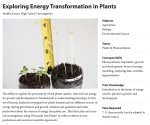Exploring Energy Transformation in Plants
View This Resource
In this set of lessons and Fast Plants experiment, students investigate how plants harness and use different sources of energy during germination and growth. Students ask questions and make predictions about the sources of energy that plants use. They then plan and carry out investigations using Wisconsin Fast Plants® to collect evidence to test predictions and construct scientific arguments.
Alternate Title
Light vs. Dark: Do Fast Plants seeds need light to grow?
Subject
Species
Phenotypic Trait
Media Format
Materials Development Era
Resource Type
Language
Typical Learning Time
1 week
Education Level
Creator
Contributor
Publisher
Source
Great Lakes Bioenergy Research Center
Rights
Share and Share Alike Non-Commercial Use
Date Issued
2012
Email Address
info@fastplants.org
Classification
- Educational Resources
- Educational Resources -- Grade Level: Secondary
- Educational Resources -- Grade Level: Middle School
- Educational Resources -- Grade Level: Elementary -- Current Elementary Resources
- Educational Resources -- Grade Level: Middle School -- Current Middle Level Resources
- Educational Resources -- Grade Level: Secondary -- Current Secondary Resources
NGSS Standard
- NGSS.HS.LS1.5 Use a model to illustrate how photosynthesis transforms light energy into stored chemical energy. [Clarification Statement: Emphasis is on illustrating inputs and outputs of matter and the transfer and transformation of energy in photosynthesis by plants and other photosynthesizing organisms. Examples of models could include diagrams, chemical equations, and conceptual models.] [Assessment Boundary: Assessment does not include specific biochemical steps.]
- NGSS.HS.LS1.7 Use a model to illustrate that cellular respiration is a chemical process whereby the bonds of food molecules and oxygen molecules are broken and the bonds in new compounds are formed resulting in a net transfer of energy. [Clarification Statement: Emphasis is on the conceptual understanding of the inputs and outputs of the process of cellular respiration.] [Assessment Boundary: Assessment should not include identification of the steps or specific processes involved in cellular respiration.]
- NGSS.MS.LS1.6 Construct a scientific explanation based on evidence for the role of photosynthesis in the cycling of matter and flow of energy into and out of organisms. [Clarification Statement: Emphasis is on tracing movement of matter and flow of energy.] [Assessment Boundary: Assessment does not include the biochemical mechanisms of photosynthesis.]
- NGSS.MS.LS2.3 Develop a model to describe the cycling of matter and flow of energy among living and nonliving parts of an ecosystem. [Clarification Statement: Emphasis is on describing the conservation of matter and flow of energy into and out of various ecosystems, and on defining the boundaries of the system.] [Assessment Boundary: Assessment does not include the use of chemical reactions to describe the processes.]

Comments